HLSC122 - Evidence For Practice Nursing Assignment
VerifiedAdded on 2020/04/29
|11
|2581
|87
AI Summary
Contribute Materials
Your contribution can guide someone’s learning journey. Share your
documents today.
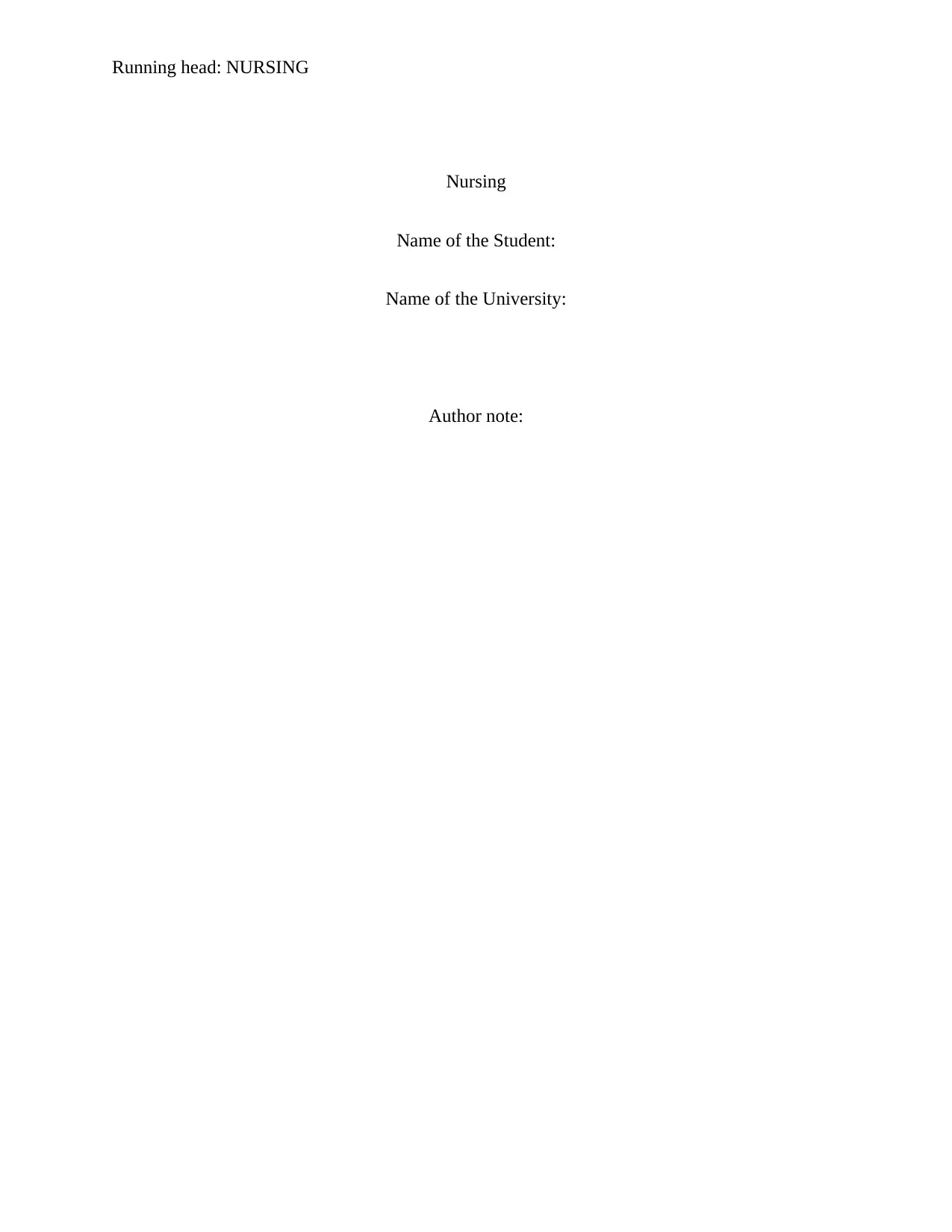
Running head: NURSING
Nursing
Name of the Student:
Name of the University:
Author note:
Nursing
Name of the Student:
Name of the University:
Author note:
Secure Best Marks with AI Grader
Need help grading? Try our AI Grader for instant feedback on your assignments.
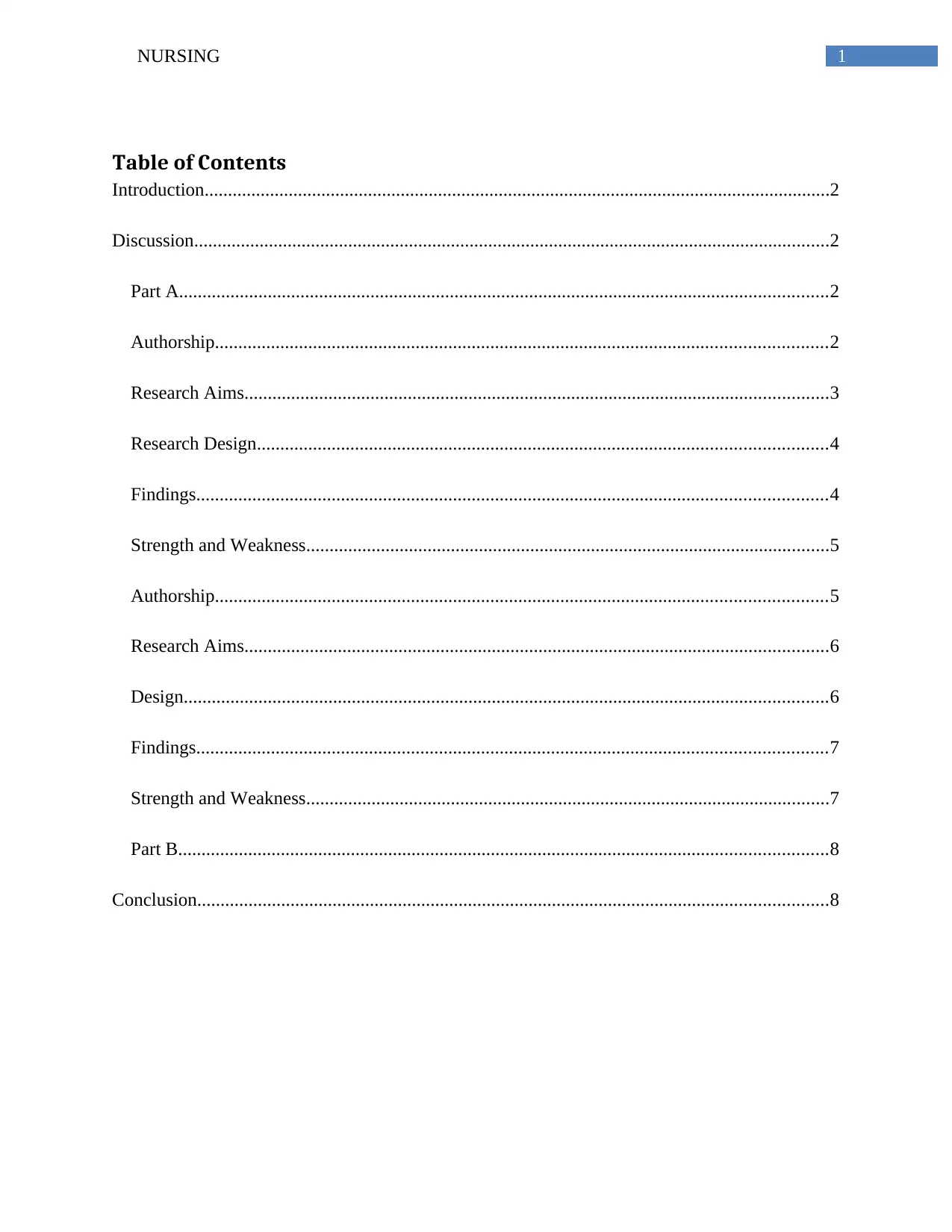
1NURSING
Table of Contents
Introduction......................................................................................................................................2
Discussion........................................................................................................................................2
Part A...........................................................................................................................................2
Authorship...................................................................................................................................2
Research Aims.............................................................................................................................3
Research Design..........................................................................................................................4
Findings.......................................................................................................................................4
Strength and Weakness................................................................................................................5
Authorship...................................................................................................................................5
Research Aims.............................................................................................................................6
Design..........................................................................................................................................6
Findings.......................................................................................................................................7
Strength and Weakness................................................................................................................7
Part B...........................................................................................................................................8
Conclusion.......................................................................................................................................8
Table of Contents
Introduction......................................................................................................................................2
Discussion........................................................................................................................................2
Part A...........................................................................................................................................2
Authorship...................................................................................................................................2
Research Aims.............................................................................................................................3
Research Design..........................................................................................................................4
Findings.......................................................................................................................................4
Strength and Weakness................................................................................................................5
Authorship...................................................................................................................................5
Research Aims.............................................................................................................................6
Design..........................................................................................................................................6
Findings.......................................................................................................................................7
Strength and Weakness................................................................................................................7
Part B...........................................................................................................................................8
Conclusion.......................................................................................................................................8
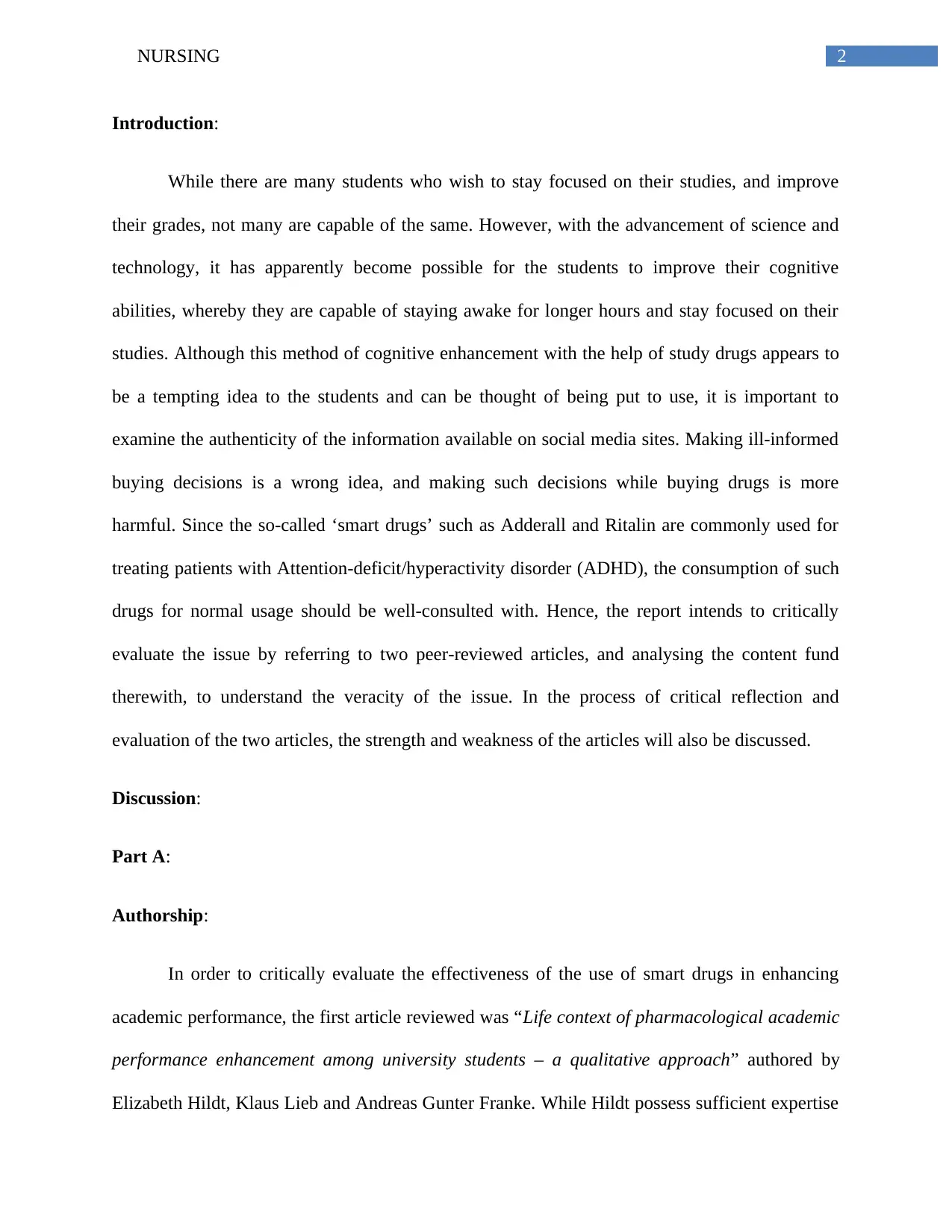
2NURSING
Introduction:
While there are many students who wish to stay focused on their studies, and improve
their grades, not many are capable of the same. However, with the advancement of science and
technology, it has apparently become possible for the students to improve their cognitive
abilities, whereby they are capable of staying awake for longer hours and stay focused on their
studies. Although this method of cognitive enhancement with the help of study drugs appears to
be a tempting idea to the students and can be thought of being put to use, it is important to
examine the authenticity of the information available on social media sites. Making ill-informed
buying decisions is a wrong idea, and making such decisions while buying drugs is more
harmful. Since the so-called ‘smart drugs’ such as Adderall and Ritalin are commonly used for
treating patients with Attention-deficit/hyperactivity disorder (ADHD), the consumption of such
drugs for normal usage should be well-consulted with. Hence, the report intends to critically
evaluate the issue by referring to two peer-reviewed articles, and analysing the content fund
therewith, to understand the veracity of the issue. In the process of critical reflection and
evaluation of the two articles, the strength and weakness of the articles will also be discussed.
Discussion:
Part A:
Authorship:
In order to critically evaluate the effectiveness of the use of smart drugs in enhancing
academic performance, the first article reviewed was “Life context of pharmacological academic
performance enhancement among university students – a qualitative approach” authored by
Elizabeth Hildt, Klaus Lieb and Andreas Gunter Franke. While Hildt possess sufficient expertise
Introduction:
While there are many students who wish to stay focused on their studies, and improve
their grades, not many are capable of the same. However, with the advancement of science and
technology, it has apparently become possible for the students to improve their cognitive
abilities, whereby they are capable of staying awake for longer hours and stay focused on their
studies. Although this method of cognitive enhancement with the help of study drugs appears to
be a tempting idea to the students and can be thought of being put to use, it is important to
examine the authenticity of the information available on social media sites. Making ill-informed
buying decisions is a wrong idea, and making such decisions while buying drugs is more
harmful. Since the so-called ‘smart drugs’ such as Adderall and Ritalin are commonly used for
treating patients with Attention-deficit/hyperactivity disorder (ADHD), the consumption of such
drugs for normal usage should be well-consulted with. Hence, the report intends to critically
evaluate the issue by referring to two peer-reviewed articles, and analysing the content fund
therewith, to understand the veracity of the issue. In the process of critical reflection and
evaluation of the two articles, the strength and weakness of the articles will also be discussed.
Discussion:
Part A:
Authorship:
In order to critically evaluate the effectiveness of the use of smart drugs in enhancing
academic performance, the first article reviewed was “Life context of pharmacological academic
performance enhancement among university students – a qualitative approach” authored by
Elizabeth Hildt, Klaus Lieb and Andreas Gunter Franke. While Hildt possess sufficient expertise

3NURSING
in the field of academic research, being a Professor of Philosophy, and having contributed
multiple research papers on ethical and philosophical issues in the field of cognitive
enhancement, Klaus Lieb is the Director in the Department for Psychiatry and Psychotherapy at
the Mainz University Medical Center for the last 10 years. The authors are highly knowledgeable
in the field of medical research, each one of them being engaged in the field of medical research,
and hence their research skills can be relied upon. The possibility of conflicts of interest could
not be completely ruled out given that one of the paper’s authors Hildt is a Philosophy Prfessor,
and she might be driven by the moral implication of taking a smart drug, rather than the scientific
base, like her co-workers, Lieb and Franke.
Research Aims:
The aim of the research paper was to discover if the non-medical use of the smart drugs is
permissible, as far as healthy individuals with no ADHD case history are concerned. The next
aim of the research has been to discover that potential cognitive and non-cognitive effect of these
performance enhancing drugs on the in-takers. Lastly, the research also intended to understand
the side-effects of intake of such drugs, in case the drug was consumed without any medical
prescription. Accordingly, the research questions were as follows (implied, not stated):
1. Do the students who use the smart drugs, use it on an illicit basis and without medical
prescription?
2. Do the drugs help in enhancing the academic performance of the students?
3. Is there any side-effect associated with the intake of such stimulant drugs?
The authors have clearly justified the need and scope of the research on three grounds. First of
all, they stated that there is limited or no evidence regarding the side-effects of the intake of such
in the field of academic research, being a Professor of Philosophy, and having contributed
multiple research papers on ethical and philosophical issues in the field of cognitive
enhancement, Klaus Lieb is the Director in the Department for Psychiatry and Psychotherapy at
the Mainz University Medical Center for the last 10 years. The authors are highly knowledgeable
in the field of medical research, each one of them being engaged in the field of medical research,
and hence their research skills can be relied upon. The possibility of conflicts of interest could
not be completely ruled out given that one of the paper’s authors Hildt is a Philosophy Prfessor,
and she might be driven by the moral implication of taking a smart drug, rather than the scientific
base, like her co-workers, Lieb and Franke.
Research Aims:
The aim of the research paper was to discover if the non-medical use of the smart drugs is
permissible, as far as healthy individuals with no ADHD case history are concerned. The next
aim of the research has been to discover that potential cognitive and non-cognitive effect of these
performance enhancing drugs on the in-takers. Lastly, the research also intended to understand
the side-effects of intake of such drugs, in case the drug was consumed without any medical
prescription. Accordingly, the research questions were as follows (implied, not stated):
1. Do the students who use the smart drugs, use it on an illicit basis and without medical
prescription?
2. Do the drugs help in enhancing the academic performance of the students?
3. Is there any side-effect associated with the intake of such stimulant drugs?
The authors have clearly justified the need and scope of the research on three grounds. First of
all, they stated that there is limited or no evidence regarding the side-effects of the intake of such
Secure Best Marks with AI Grader
Need help grading? Try our AI Grader for instant feedback on your assignments.
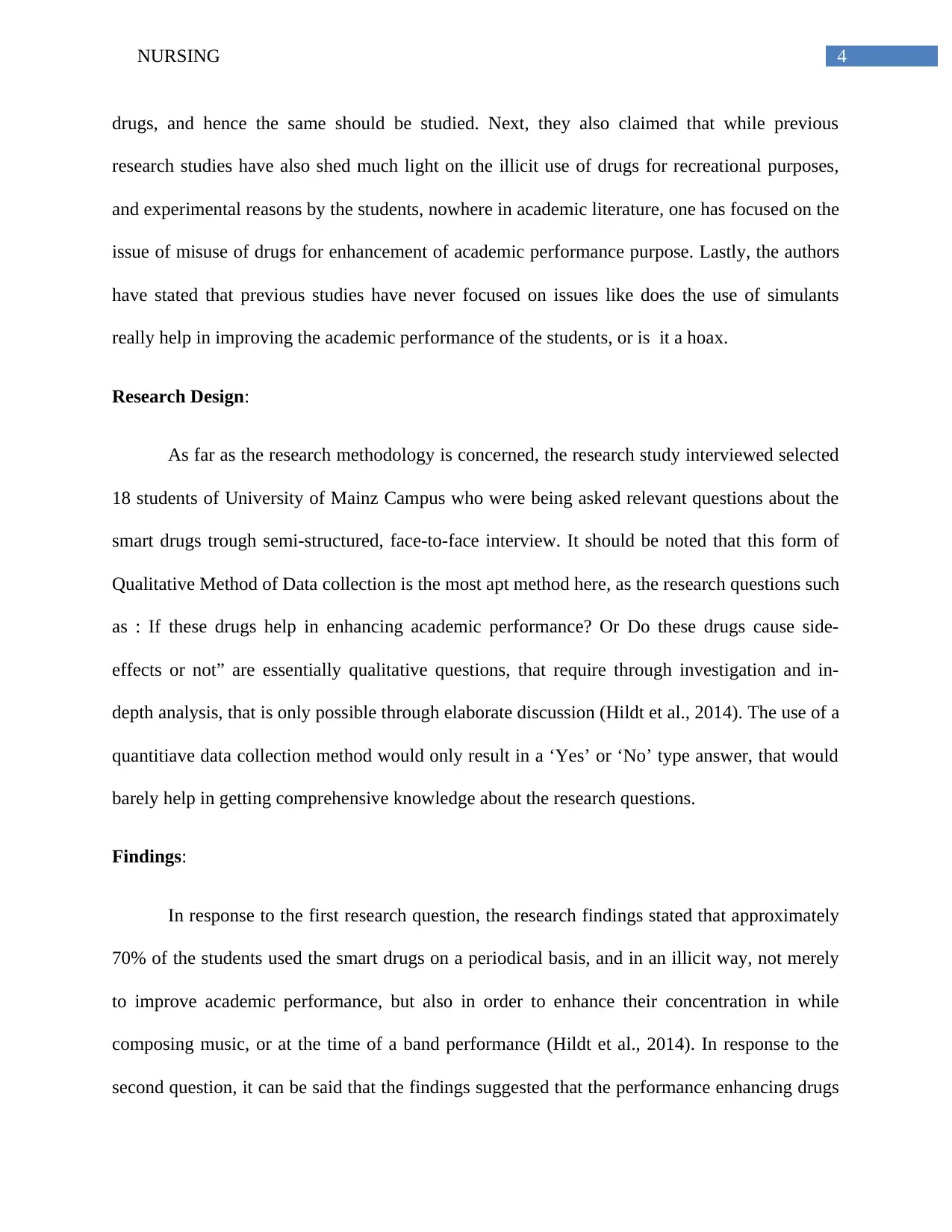
4NURSING
drugs, and hence the same should be studied. Next, they also claimed that while previous
research studies have also shed much light on the illicit use of drugs for recreational purposes,
and experimental reasons by the students, nowhere in academic literature, one has focused on the
issue of misuse of drugs for enhancement of academic performance purpose. Lastly, the authors
have stated that previous studies have never focused on issues like does the use of simulants
really help in improving the academic performance of the students, or is it a hoax.
Research Design:
As far as the research methodology is concerned, the research study interviewed selected
18 students of University of Mainz Campus who were being asked relevant questions about the
smart drugs trough semi-structured, face-to-face interview. It should be noted that this form of
Qualitative Method of Data collection is the most apt method here, as the research questions such
as : If these drugs help in enhancing academic performance? Or Do these drugs cause side-
effects or not” are essentially qualitative questions, that require through investigation and in-
depth analysis, that is only possible through elaborate discussion (Hildt et al., 2014). The use of a
quantitiave data collection method would only result in a ‘Yes’ or ‘No’ type answer, that would
barely help in getting comprehensive knowledge about the research questions.
Findings:
In response to the first research question, the research findings stated that approximately
70% of the students used the smart drugs on a periodical basis, and in an illicit way, not merely
to improve academic performance, but also in order to enhance their concentration in while
composing music, or at the time of a band performance (Hildt et al., 2014). In response to the
second question, it can be said that the findings suggested that the performance enhancing drugs
drugs, and hence the same should be studied. Next, they also claimed that while previous
research studies have also shed much light on the illicit use of drugs for recreational purposes,
and experimental reasons by the students, nowhere in academic literature, one has focused on the
issue of misuse of drugs for enhancement of academic performance purpose. Lastly, the authors
have stated that previous studies have never focused on issues like does the use of simulants
really help in improving the academic performance of the students, or is it a hoax.
Research Design:
As far as the research methodology is concerned, the research study interviewed selected
18 students of University of Mainz Campus who were being asked relevant questions about the
smart drugs trough semi-structured, face-to-face interview. It should be noted that this form of
Qualitative Method of Data collection is the most apt method here, as the research questions such
as : If these drugs help in enhancing academic performance? Or Do these drugs cause side-
effects or not” are essentially qualitative questions, that require through investigation and in-
depth analysis, that is only possible through elaborate discussion (Hildt et al., 2014). The use of a
quantitiave data collection method would only result in a ‘Yes’ or ‘No’ type answer, that would
barely help in getting comprehensive knowledge about the research questions.
Findings:
In response to the first research question, the research findings stated that approximately
70% of the students used the smart drugs on a periodical basis, and in an illicit way, not merely
to improve academic performance, but also in order to enhance their concentration in while
composing music, or at the time of a band performance (Hildt et al., 2014). In response to the
second question, it can be said that the findings suggested that the performance enhancing drugs
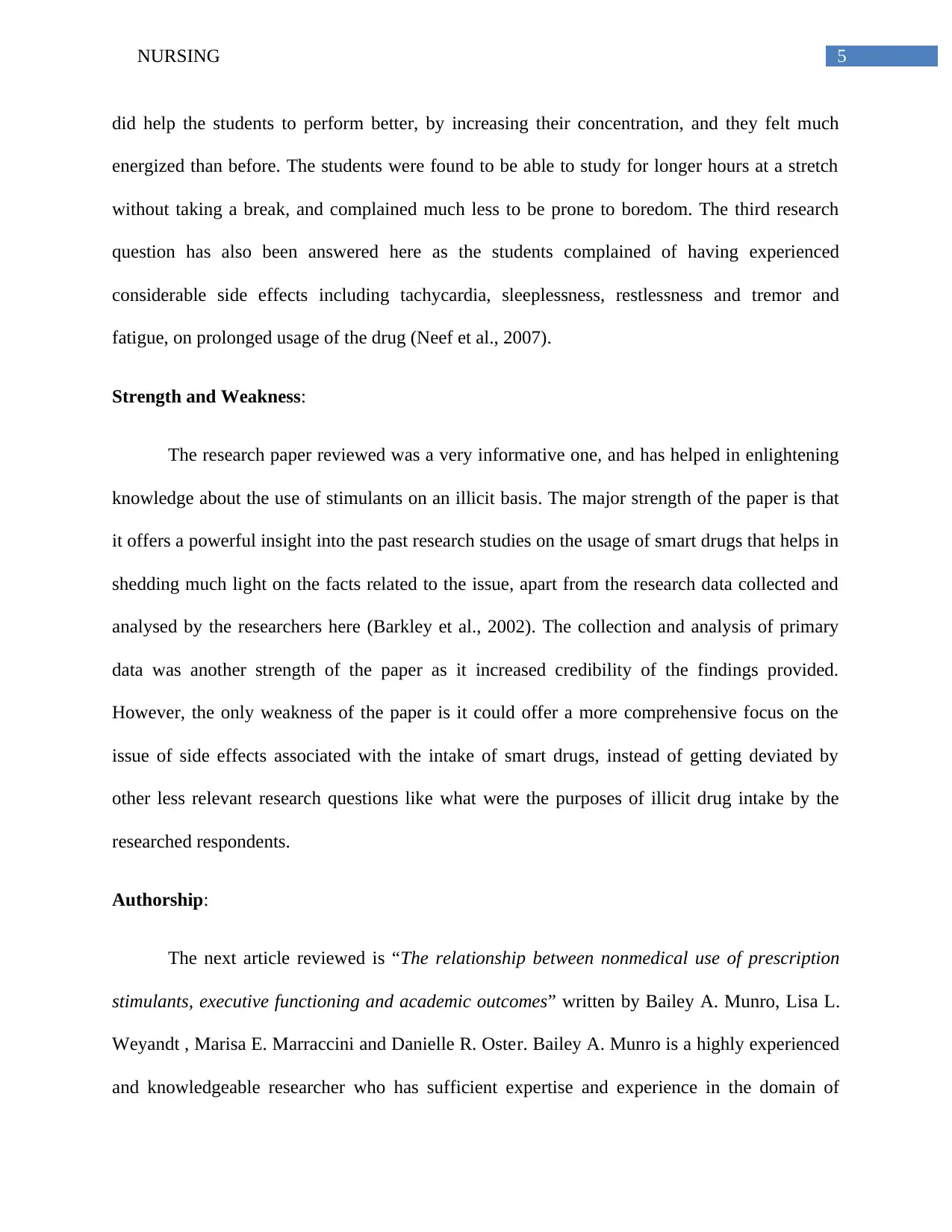
5NURSING
did help the students to perform better, by increasing their concentration, and they felt much
energized than before. The students were found to be able to study for longer hours at a stretch
without taking a break, and complained much less to be prone to boredom. The third research
question has also been answered here as the students complained of having experienced
considerable side effects including tachycardia, sleeplessness, restlessness and tremor and
fatigue, on prolonged usage of the drug (Neef et al., 2007).
Strength and Weakness:
The research paper reviewed was a very informative one, and has helped in enlightening
knowledge about the use of stimulants on an illicit basis. The major strength of the paper is that
it offers a powerful insight into the past research studies on the usage of smart drugs that helps in
shedding much light on the facts related to the issue, apart from the research data collected and
analysed by the researchers here (Barkley et al., 2002). The collection and analysis of primary
data was another strength of the paper as it increased credibility of the findings provided.
However, the only weakness of the paper is it could offer a more comprehensive focus on the
issue of side effects associated with the intake of smart drugs, instead of getting deviated by
other less relevant research questions like what were the purposes of illicit drug intake by the
researched respondents.
Authorship:
The next article reviewed is “The relationship between nonmedical use of prescription
stimulants, executive functioning and academic outcomes” written by Bailey A. Munro, Lisa L.
Weyandt , Marisa E. Marraccini and Danielle R. Oster. Bailey A. Munro is a highly experienced
and knowledgeable researcher who has sufficient expertise and experience in the domain of
did help the students to perform better, by increasing their concentration, and they felt much
energized than before. The students were found to be able to study for longer hours at a stretch
without taking a break, and complained much less to be prone to boredom. The third research
question has also been answered here as the students complained of having experienced
considerable side effects including tachycardia, sleeplessness, restlessness and tremor and
fatigue, on prolonged usage of the drug (Neef et al., 2007).
Strength and Weakness:
The research paper reviewed was a very informative one, and has helped in enlightening
knowledge about the use of stimulants on an illicit basis. The major strength of the paper is that
it offers a powerful insight into the past research studies on the usage of smart drugs that helps in
shedding much light on the facts related to the issue, apart from the research data collected and
analysed by the researchers here (Barkley et al., 2002). The collection and analysis of primary
data was another strength of the paper as it increased credibility of the findings provided.
However, the only weakness of the paper is it could offer a more comprehensive focus on the
issue of side effects associated with the intake of smart drugs, instead of getting deviated by
other less relevant research questions like what were the purposes of illicit drug intake by the
researched respondents.
Authorship:
The next article reviewed is “The relationship between nonmedical use of prescription
stimulants, executive functioning and academic outcomes” written by Bailey A. Munro, Lisa L.
Weyandt , Marisa E. Marraccini and Danielle R. Oster. Bailey A. Munro is a highly experienced
and knowledgeable researcher who has sufficient expertise and experience in the domain of
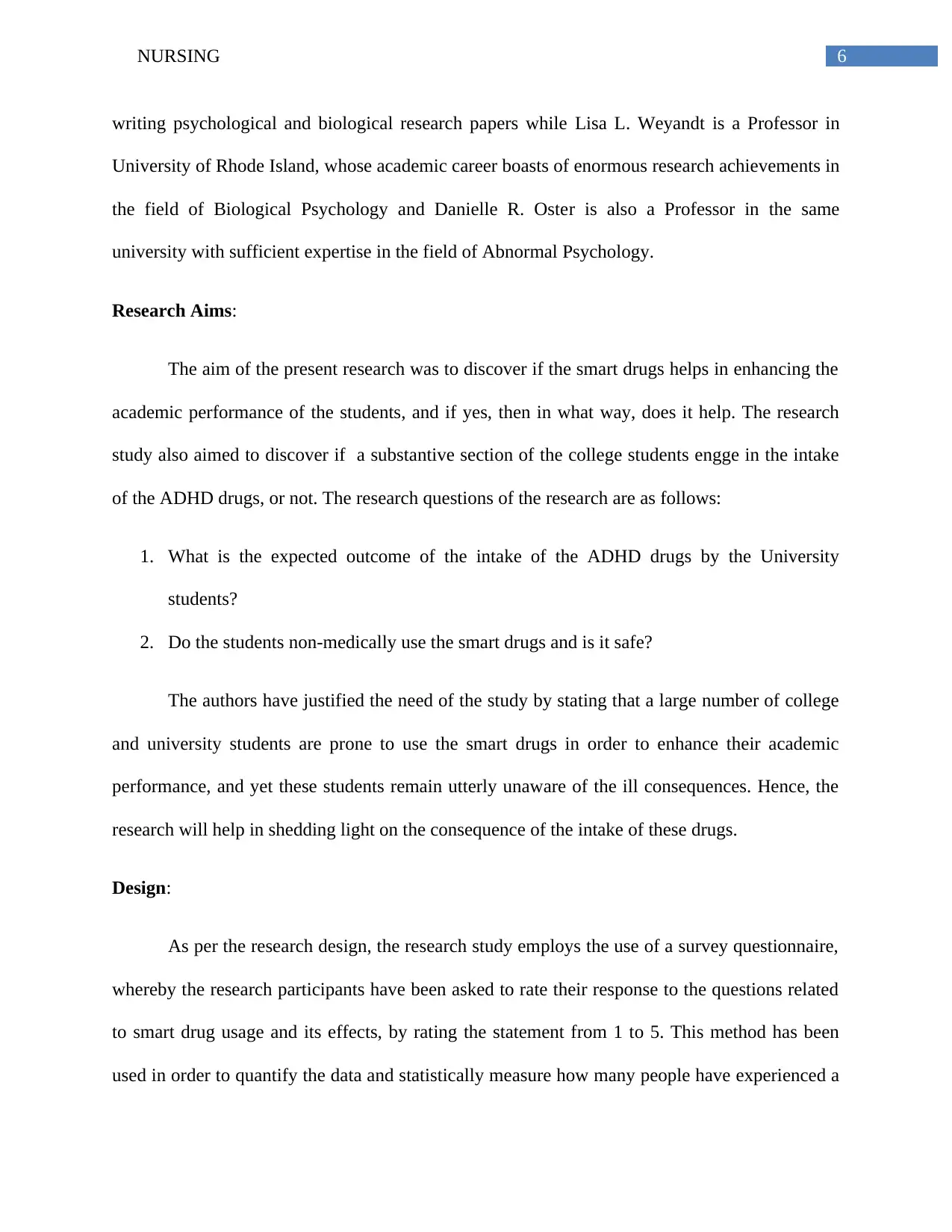
6NURSING
writing psychological and biological research papers while Lisa L. Weyandt is a Professor in
University of Rhode Island, whose academic career boasts of enormous research achievements in
the field of Biological Psychology and Danielle R. Oster is also a Professor in the same
university with sufficient expertise in the field of Abnormal Psychology.
Research Aims:
The aim of the present research was to discover if the smart drugs helps in enhancing the
academic performance of the students, and if yes, then in what way, does it help. The research
study also aimed to discover if a substantive section of the college students engge in the intake
of the ADHD drugs, or not. The research questions of the research are as follows:
1. What is the expected outcome of the intake of the ADHD drugs by the University
students?
2. Do the students non-medically use the smart drugs and is it safe?
The authors have justified the need of the study by stating that a large number of college
and university students are prone to use the smart drugs in order to enhance their academic
performance, and yet these students remain utterly unaware of the ill consequences. Hence, the
research will help in shedding light on the consequence of the intake of these drugs.
Design:
As per the research design, the research study employs the use of a survey questionnaire,
whereby the research participants have been asked to rate their response to the questions related
to smart drug usage and its effects, by rating the statement from 1 to 5. This method has been
used in order to quantify the data and statistically measure how many people have experienced a
writing psychological and biological research papers while Lisa L. Weyandt is a Professor in
University of Rhode Island, whose academic career boasts of enormous research achievements in
the field of Biological Psychology and Danielle R. Oster is also a Professor in the same
university with sufficient expertise in the field of Abnormal Psychology.
Research Aims:
The aim of the present research was to discover if the smart drugs helps in enhancing the
academic performance of the students, and if yes, then in what way, does it help. The research
study also aimed to discover if a substantive section of the college students engge in the intake
of the ADHD drugs, or not. The research questions of the research are as follows:
1. What is the expected outcome of the intake of the ADHD drugs by the University
students?
2. Do the students non-medically use the smart drugs and is it safe?
The authors have justified the need of the study by stating that a large number of college
and university students are prone to use the smart drugs in order to enhance their academic
performance, and yet these students remain utterly unaware of the ill consequences. Hence, the
research will help in shedding light on the consequence of the intake of these drugs.
Design:
As per the research design, the research study employs the use of a survey questionnaire,
whereby the research participants have been asked to rate their response to the questions related
to smart drug usage and its effects, by rating the statement from 1 to 5. This method has been
used in order to quantify the data and statistically measure how many people have experienced a
Paraphrase This Document
Need a fresh take? Get an instant paraphrase of this document with our AI Paraphraser
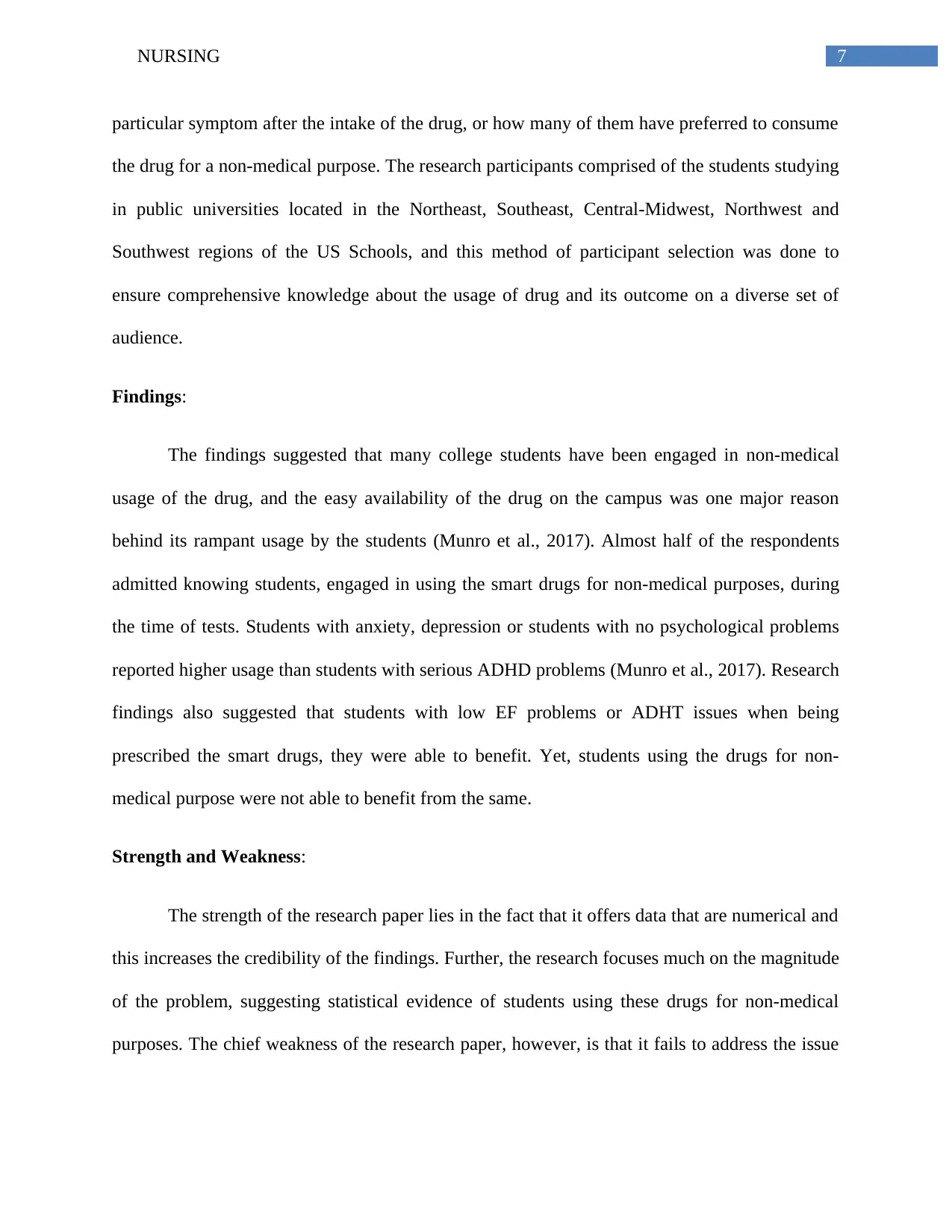
7NURSING
particular symptom after the intake of the drug, or how many of them have preferred to consume
the drug for a non-medical purpose. The research participants comprised of the students studying
in public universities located in the Northeast, Southeast, Central-Midwest, Northwest and
Southwest regions of the US Schools, and this method of participant selection was done to
ensure comprehensive knowledge about the usage of drug and its outcome on a diverse set of
audience.
Findings:
The findings suggested that many college students have been engaged in non-medical
usage of the drug, and the easy availability of the drug on the campus was one major reason
behind its rampant usage by the students (Munro et al., 2017). Almost half of the respondents
admitted knowing students, engaged in using the smart drugs for non-medical purposes, during
the time of tests. Students with anxiety, depression or students with no psychological problems
reported higher usage than students with serious ADHD problems (Munro et al., 2017). Research
findings also suggested that students with low EF problems or ADHT issues when being
prescribed the smart drugs, they were able to benefit. Yet, students using the drugs for non-
medical purpose were not able to benefit from the same.
Strength and Weakness:
The strength of the research paper lies in the fact that it offers data that are numerical and
this increases the credibility of the findings. Further, the research focuses much on the magnitude
of the problem, suggesting statistical evidence of students using these drugs for non-medical
purposes. The chief weakness of the research paper, however, is that it fails to address the issue
particular symptom after the intake of the drug, or how many of them have preferred to consume
the drug for a non-medical purpose. The research participants comprised of the students studying
in public universities located in the Northeast, Southeast, Central-Midwest, Northwest and
Southwest regions of the US Schools, and this method of participant selection was done to
ensure comprehensive knowledge about the usage of drug and its outcome on a diverse set of
audience.
Findings:
The findings suggested that many college students have been engaged in non-medical
usage of the drug, and the easy availability of the drug on the campus was one major reason
behind its rampant usage by the students (Munro et al., 2017). Almost half of the respondents
admitted knowing students, engaged in using the smart drugs for non-medical purposes, during
the time of tests. Students with anxiety, depression or students with no psychological problems
reported higher usage than students with serious ADHD problems (Munro et al., 2017). Research
findings also suggested that students with low EF problems or ADHT issues when being
prescribed the smart drugs, they were able to benefit. Yet, students using the drugs for non-
medical purpose were not able to benefit from the same.
Strength and Weakness:
The strength of the research paper lies in the fact that it offers data that are numerical and
this increases the credibility of the findings. Further, the research focuses much on the magnitude
of the problem, suggesting statistical evidence of students using these drugs for non-medical
purposes. The chief weakness of the research paper, however, is that it fails to address the issue
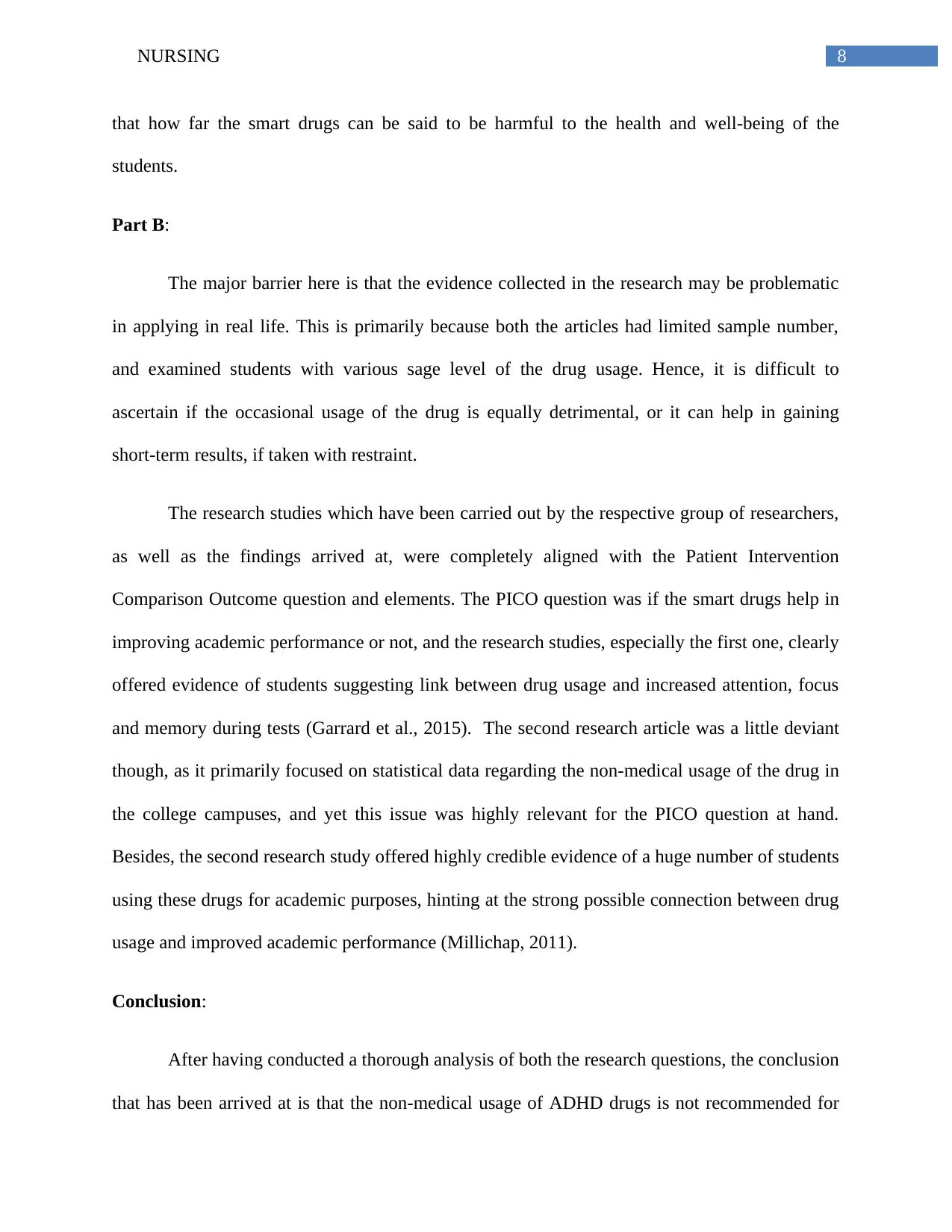
8NURSING
that how far the smart drugs can be said to be harmful to the health and well-being of the
students.
Part B:
The major barrier here is that the evidence collected in the research may be problematic
in applying in real life. This is primarily because both the articles had limited sample number,
and examined students with various sage level of the drug usage. Hence, it is difficult to
ascertain if the occasional usage of the drug is equally detrimental, or it can help in gaining
short-term results, if taken with restraint.
The research studies which have been carried out by the respective group of researchers,
as well as the findings arrived at, were completely aligned with the Patient Intervention
Comparison Outcome question and elements. The PICO question was if the smart drugs help in
improving academic performance or not, and the research studies, especially the first one, clearly
offered evidence of students suggesting link between drug usage and increased attention, focus
and memory during tests (Garrard et al., 2015). The second research article was a little deviant
though, as it primarily focused on statistical data regarding the non-medical usage of the drug in
the college campuses, and yet this issue was highly relevant for the PICO question at hand.
Besides, the second research study offered highly credible evidence of a huge number of students
using these drugs for academic purposes, hinting at the strong possible connection between drug
usage and improved academic performance (Millichap, 2011).
Conclusion:
After having conducted a thorough analysis of both the research questions, the conclusion
that has been arrived at is that the non-medical usage of ADHD drugs is not recommended for
that how far the smart drugs can be said to be harmful to the health and well-being of the
students.
Part B:
The major barrier here is that the evidence collected in the research may be problematic
in applying in real life. This is primarily because both the articles had limited sample number,
and examined students with various sage level of the drug usage. Hence, it is difficult to
ascertain if the occasional usage of the drug is equally detrimental, or it can help in gaining
short-term results, if taken with restraint.
The research studies which have been carried out by the respective group of researchers,
as well as the findings arrived at, were completely aligned with the Patient Intervention
Comparison Outcome question and elements. The PICO question was if the smart drugs help in
improving academic performance or not, and the research studies, especially the first one, clearly
offered evidence of students suggesting link between drug usage and increased attention, focus
and memory during tests (Garrard et al., 2015). The second research article was a little deviant
though, as it primarily focused on statistical data regarding the non-medical usage of the drug in
the college campuses, and yet this issue was highly relevant for the PICO question at hand.
Besides, the second research study offered highly credible evidence of a huge number of students
using these drugs for academic purposes, hinting at the strong possible connection between drug
usage and improved academic performance (Millichap, 2011).
Conclusion:
After having conducted a thorough analysis of both the research questions, the conclusion
that has been arrived at is that the non-medical usage of ADHD drugs is not recommended for
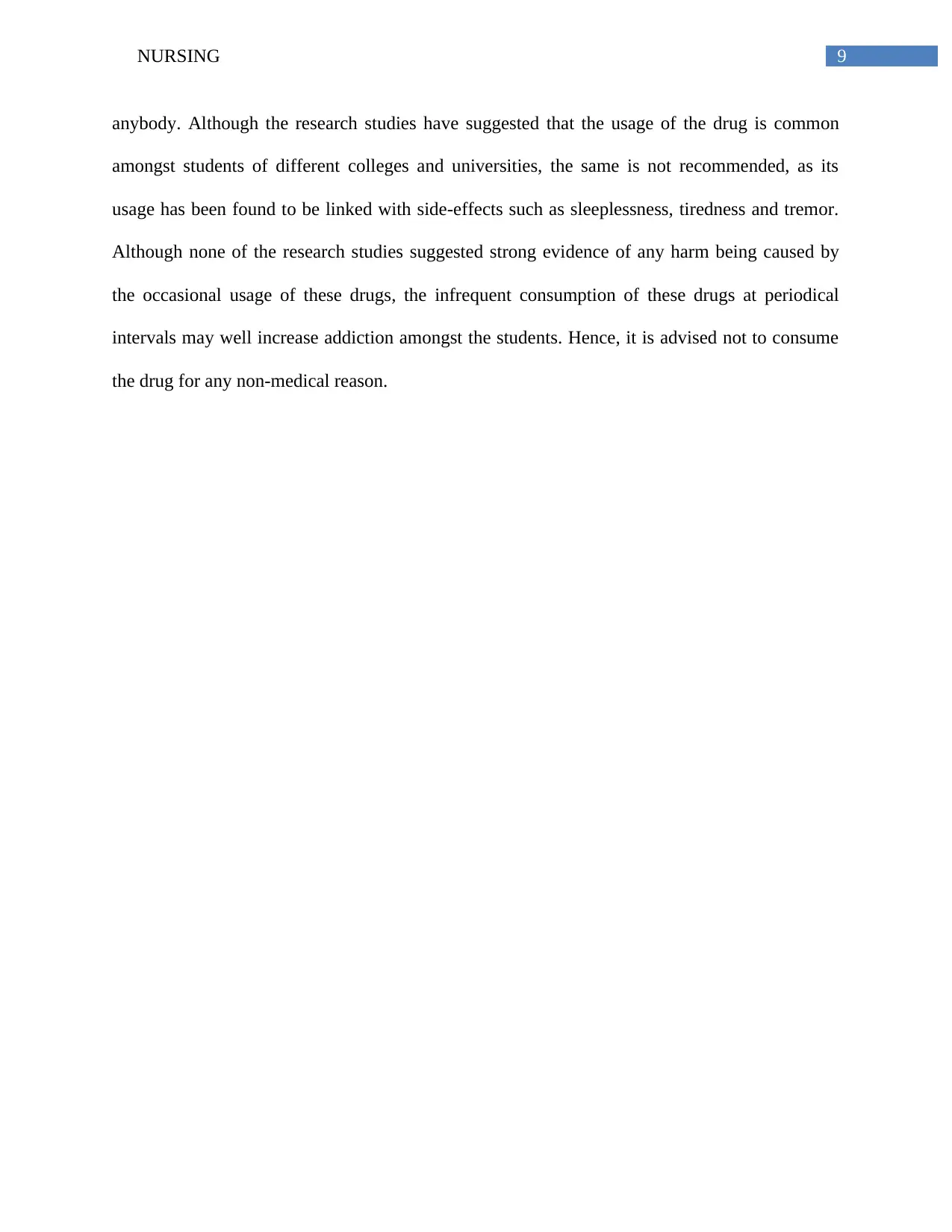
9NURSING
anybody. Although the research studies have suggested that the usage of the drug is common
amongst students of different colleges and universities, the same is not recommended, as its
usage has been found to be linked with side-effects such as sleeplessness, tiredness and tremor.
Although none of the research studies suggested strong evidence of any harm being caused by
the occasional usage of these drugs, the infrequent consumption of these drugs at periodical
intervals may well increase addiction amongst the students. Hence, it is advised not to consume
the drug for any non-medical reason.
anybody. Although the research studies have suggested that the usage of the drug is common
amongst students of different colleges and universities, the same is not recommended, as its
usage has been found to be linked with side-effects such as sleeplessness, tiredness and tremor.
Although none of the research studies suggested strong evidence of any harm being caused by
the occasional usage of these drugs, the infrequent consumption of these drugs at periodical
intervals may well increase addiction amongst the students. Hence, it is advised not to consume
the drug for any non-medical reason.
Secure Best Marks with AI Grader
Need help grading? Try our AI Grader for instant feedback on your assignments.
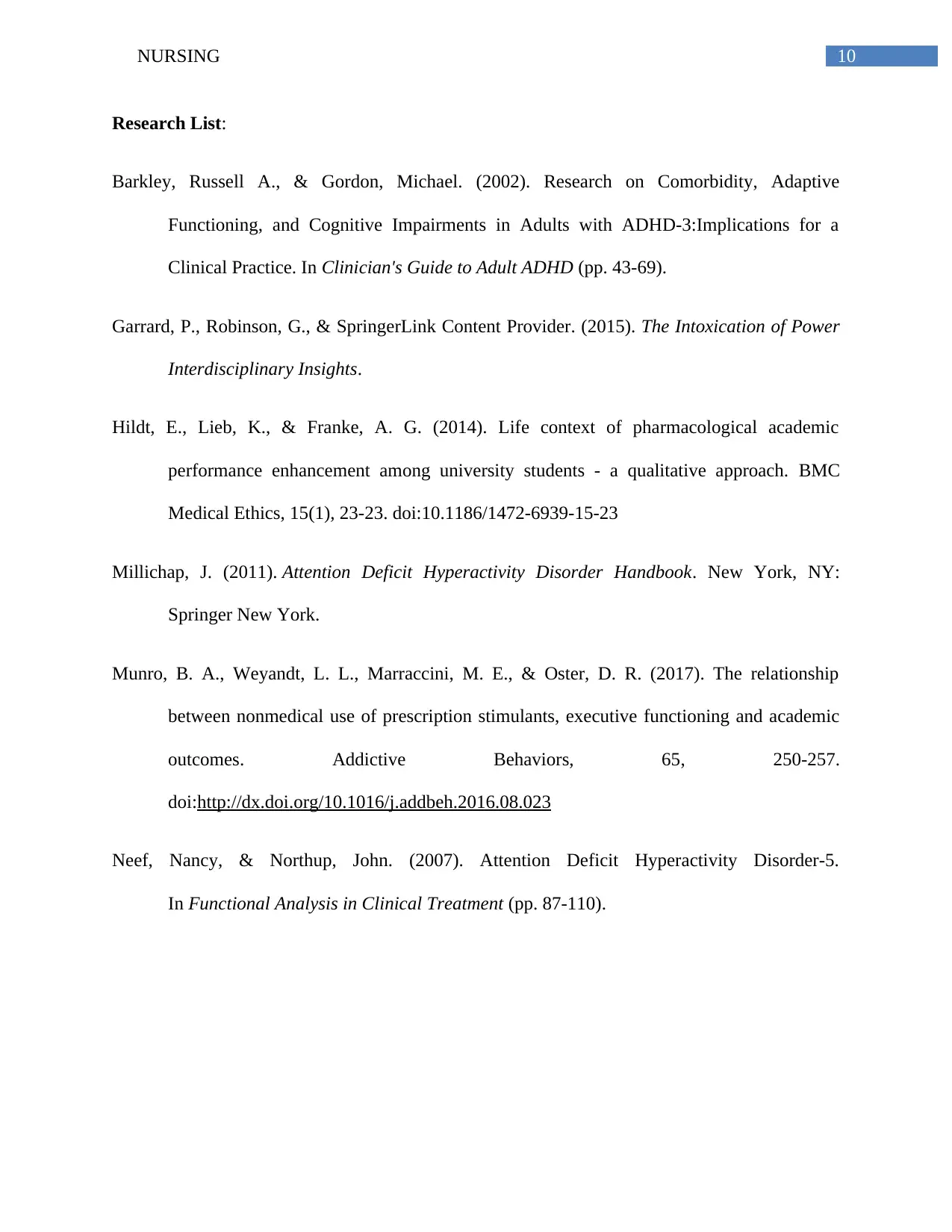
10NURSING
Research List:
Barkley, Russell A., & Gordon, Michael. (2002). Research on Comorbidity, Adaptive
Functioning, and Cognitive Impairments in Adults with ADHD-3:Implications for a
Clinical Practice. In Clinician's Guide to Adult ADHD (pp. 43-69).
Garrard, P., Robinson, G., & SpringerLink Content Provider. (2015). The Intoxication of Power
Interdisciplinary Insights.
Hildt, E., Lieb, K., & Franke, A. G. (2014). Life context of pharmacological academic
performance enhancement among university students - a qualitative approach. BMC
Medical Ethics, 15(1), 23-23. doi:10.1186/1472-6939-15-23
Millichap, J. (2011). Attention Deficit Hyperactivity Disorder Handbook. New York, NY:
Springer New York.
Munro, B. A., Weyandt, L. L., Marraccini, M. E., & Oster, D. R. (2017). The relationship
between nonmedical use of prescription stimulants, executive functioning and academic
outcomes. Addictive Behaviors, 65, 250-257.
doi:http://dx.doi.org/10.1016/j.addbeh.2016.08.023
Neef, Nancy, & Northup, John. (2007). Attention Deficit Hyperactivity Disorder-5.
In Functional Analysis in Clinical Treatment (pp. 87-110).
Research List:
Barkley, Russell A., & Gordon, Michael. (2002). Research on Comorbidity, Adaptive
Functioning, and Cognitive Impairments in Adults with ADHD-3:Implications for a
Clinical Practice. In Clinician's Guide to Adult ADHD (pp. 43-69).
Garrard, P., Robinson, G., & SpringerLink Content Provider. (2015). The Intoxication of Power
Interdisciplinary Insights.
Hildt, E., Lieb, K., & Franke, A. G. (2014). Life context of pharmacological academic
performance enhancement among university students - a qualitative approach. BMC
Medical Ethics, 15(1), 23-23. doi:10.1186/1472-6939-15-23
Millichap, J. (2011). Attention Deficit Hyperactivity Disorder Handbook. New York, NY:
Springer New York.
Munro, B. A., Weyandt, L. L., Marraccini, M. E., & Oster, D. R. (2017). The relationship
between nonmedical use of prescription stimulants, executive functioning and academic
outcomes. Addictive Behaviors, 65, 250-257.
doi:http://dx.doi.org/10.1016/j.addbeh.2016.08.023
Neef, Nancy, & Northup, John. (2007). Attention Deficit Hyperactivity Disorder-5.
In Functional Analysis in Clinical Treatment (pp. 87-110).
1 out of 11
Related Documents
Your All-in-One AI-Powered Toolkit for Academic Success.
+13062052269
info@desklib.com
Available 24*7 on WhatsApp / Email
![[object Object]](/_next/static/media/star-bottom.7253800d.svg)
Unlock your academic potential
© 2024 | Zucol Services PVT LTD | All rights reserved.





